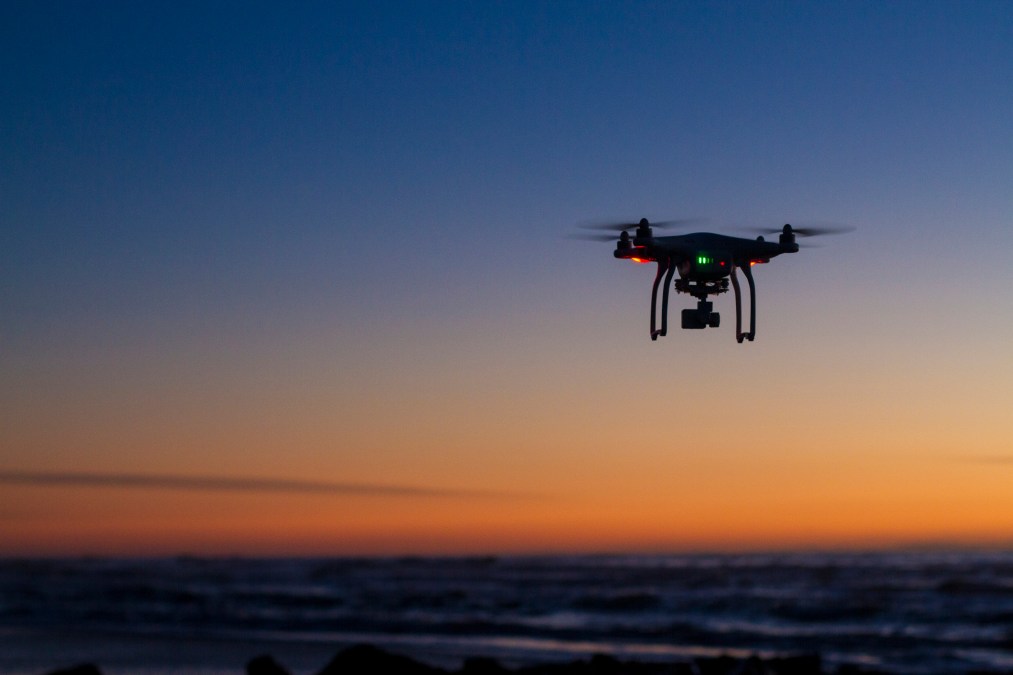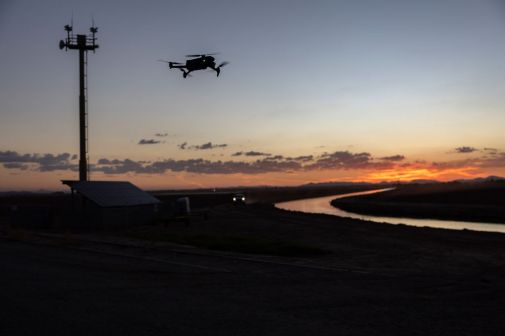Counter-drone World Cup plans include deputization of state, local law enforcement

U.S. officials are moving to deputize state and local law enforcement partners for counter-drone activities ahead of the 2026 World Cup in an attempt to address a gap in legal authorities.
While certain federal officials have been given the authority to counter unmanned aircraft that pose a credible threat to specified locations, that same authority has not yet been extended by Congress to state and local officials.
So, as U.S. cities look to enhance the security of their skies ahead of the World Cup matches they’re slated to host, the federal government is moving to train and deputize law enforcement in those areas so they, too, can participate in counter-drone efforts. Details of those plans were shared at an event Wednesday on drone mitigation co-hosted by the White House Task Force on the FIFA World Cup, Commercial Drone Alliance, and DroneResponders.
“There are some technical issues about who has the capacity to do counter-drone technology — who can operate that equipment,” former Minnesota Sen. Norm Coleman, who represents the 11 U.S. cities hosting World Cup matches on behalf of Hogan Lovells, told reporters on the sidelines of the Wednesday event.
Working with the FBI, he said, the White House is requiring officials to be trained, and “in effect, they become deputized, they become federal agents for this limited purpose.”
While Coleman said it “would be cleaner” and easier to do it via legislation, he told reporters “the public should understand that we have the capacity to ensure that the folks who need to operate the equipment will be able to do it.”
“I’m not waiting for Congress to do anything at this point in time,” Coleman added later.
Through a recently launched FBI training program known as the National Counter-UAS Training Center, state and local law enforcement officers will be educated and then granted authority by the Department of Justice for counter-drone work. That schoolhouse located in Alabama was ordered under President Donald Trump’s executive order on drone mitigation and graduated its first class last week.
In a sidebar with reporters during the event, Andrew Giuliani, who leads the White House Task Force on the FIFA World Cup 2026, said officials have made training through that school a priority for sites hosting both World Cup events as well as events for the country’s 250th anniversary celebrations coming up next year.
Giuliani described the authority law enforcement officers receive following training as a “backup plan.”
“We’re obviously hopeful that we can get legislation over the finish line,” Giuliani said. “We know that we’ve heard real interest on this all the way up to the [House] speaker’s office, so I am hopeful, but obviously we don’t want to base a World Cup plan of safety and security solely on hope.”
Extending such authority for state and local law enforcement is important as those officials explore taking advantage of a pot of $500 million in federal grants for the purchase of technologies that can “detect, identify, track, or monitor threats from unmanned aircraft systems.”
That funding was included as part of Trump’s One Big Beautiful Bill earlier this year, and just last month, the Department of Homeland Security announced applications were open for the first $250 million. The second portion is expected to be distributed in fiscal year 2027, according to a press release from the event sponsors.
Per the task force, drones pose a threat to World Cup activities, which is why officials have made it a focus.
“Unmanned aircraft systems have been identified as one of the top security threats to the World Cup by the White House Task Force, the National Security Council, and host cities,” Giuliani said during his opening remarks at the event.
As an example, Giuliani said that several stadiums experienced unauthorized drone activity during the FIFA Club Cup 2025, which he said underscores “the critical need for a robust, counter-unmanned aircraft system strategy.”
Joshua Craddock, a deputy assistant attorney general in the Justice Department’s Office of Legal Counsel, gave a presentation during the event specifically addressing the deputization process, its legal authority, and protection it provides.
Under federal statute, the DOJ and DHS not only have authority to “detect, identify, monitor, and track” drones but also disrupt control of and disable those systems if necessary. While that section technically expired at the end of September, the continuing resolution that ended the government shutdown Wednesday night included language extending that authority to Jan. 30, 2026.
When it comes to providing that authority to state and local partners, Craddock said the DOJ has the ability to, where appropriate, deputize state, local, tribal and territorial (SLTT) “law enforcement officers — such as through the FBI Joint Terrorism Task Forces — so they serve as temporary Federal officers for that mission.”
As a result, he said, those partners can assist the same counter-drone operations that personnel at the DOJ and DHS are able to carry out. They also receive similar protections.
“SLTT law enforcement officers who are properly deputized and acting within the scope of their federal authority to carry out counter UAS activities are generally protected by the same legal frameworks and defenses that apply to federal officers,” Craddock said.
Though, he noted that those protections aren’t a “blanket immunity” and depend on whether the officer is acting under lawful federal authority as well as supervision. But under that supervision and in coordination with the Federal Aviation Administration, the trained and authorized personnel can use mitigation technology such as “kinetic and non-kinetic capabilities to disable, disrupt or seize control of a UAS during flight.”
In order to use the available grant money, officials will need to undergo the training.
“Funds for these counter-UAS mitigation capabilities can be authorized only for law enforcement or correctional agencies that have personnel that have been trained at or are scheduled to be trained at the FBI National Counter-UAS Training Center on counter-UAS mitigation operations,” Craddock said.
While officials are moving ahead with their plans, lawmakers have proposed establishing a similar program and authority for state and local law enforcement. Specifically, a bipartisan bill from Rep. Andrew Garbarino, R-N.Y., would create a pilot program to achieve a very similar end. That bill advanced out of the House Committee on Transportation and Infrastructure unanimously in September.
Reacting to the plans, Jake Laperruque, deputy director of the Center for Democracy Technology’s Security and Surveillance Project, told FedScoop that the goal officials are looking to achieve isn’t a controversial one, but guardrails will be important.
“It’s certainly a reasonable and uncontroversial goal to make sure that these types of sites with large amounts of people are covered from threats,” Laperruque said. ”It’s important to be doing it and addressing them in a proper fashion with rules and guardrails that account for the fact that these are sensitive powers that can be abused.”
Technology vendors present at the event included Anduril, Skydio, AeroDefense, Amazon Web Services, and many others. For those companies, the grant opportunities are also a chance to get their foot in the door with state and local governments that may be interested in expanding their technologies for other use cases in the future.
Ben Husch, director of policy and community affairs for drone manufacturer Skydio, told FedScoop at the event that often users realize that the same drone being sent to respond to a 911 call could also be used at different times to also inspect a water tower or a bridge.
“You start to get to the concept of like a smart city, where you’re using technology to not only improve public safety, but also improve your utility assets, to improve your transportation assets, to make sure there’s not illegal dumping, and it’s just leveraging technology to make government more efficient,” Husch said.
Skydio is currently used by seven of the 11 host cities and the company expects at least one if not all the remaining sites to be customers by the start of the World Cup, Husch said.
Linda Ziemba, the founding CEO of drone detection company AeroDefense, said her company provides an affordable solution that could be deployed throughout an entire city to monitor drones. That technology provides a history of drones and the airspace so users can know the patterns of an area or where a particular drone has flown before.
“It’s affordable enough that it could be worked into a city [or] a county planning budget after the grant is over three years from now,” Ziemba said.
Lisa Ellman, chief executive officer of the Commercial Drone Alliance and chair of the UAS practice at Hogan Lovells, told FedScoop many of the tools offered by the companies at the event were digital detection technologies, which is where they see the future of airspace management. Mitigation technologies, she said, are a “last resort.”
“You have detection technologies, an understanding of what’s in the airspace, an understanding of how to secure the airspace, and then mitigation technologies in case of last resort,” Ellman said.
As the airspace evolves, the need for that technology will only increase, she said. “I see this as something where the federal government has realized that these technologies are critical to the future of … airspace management.”






